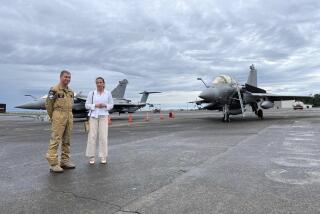Manila-U.S. Military Pact Looks Likely
- Share via
MANILA — Eight years after the Philippine Senate ordered the U.S. military out of the country, Manila appears likely to ratify a new agreement with Washington for increased military cooperation.
Although a 1951 mutual defense pact has remained in effect, the forced closure of Clark Air Base, once the largest U.S. military facility outside the continental United States, and a naval base at Subic Bay led to strains in the Manila-Washington relationship that continue to this day. No U.S. military ships have called on the Philippines for two years.
Among the most active campaigners in the nationalistic movement to close the bases were two senators, Joseph Estrada and Orlando Mercado. Estrada is now president and Mercado is his secretary of defense, and their outspoken support for the new agreement is helping to overcome considerable opposition.
“I’m 100% behind the Visiting Forces Agreement,” Estrada said. “It does not infringe on our sovereignty, and it enhances our security at a time when I’m worried that China wants to take over Asia.”
The agreement is similar to ones the United States has with 78 countries, including four in Southeast Asia: Malaysia, Singapore, Thailand and Indonesia. It permits port calls in the Philippines for U.S. ships and shore leaves there for U.S. service personnel, and it will lead to joint training exercises and closer overall military cooperation. It contains no provisions for increased military aid or for deterring external threats.
Estrada, whose armed forces are among the weakest in the region, sees the VFA as providing increased stability and security. His comment about China underscores his concern over Beijing’s presence in the Spratly Islands, 310 miles southwest of Manila in the strategic navigation routes linking the Indian and Pacific oceans.
China began building up a fortified military presence on the islands’ Mischief Reef last year, and discussions between Beijing and Manila after the Philippines’ protest have been unproductive.
“The wolf [China] is looking for new lambs to devour after Mischief Reef,” Rep. Roilo Golez said. Six nations, including China and the Philippines, claim the Spratlys, in whole or part.
Independent polls show that a substantial majority of Filipinos supports the Visiting Forces Agreement, as do business leaders, who believe the deal would promote stability needed in a time of economic crisis. The Senate will be asked to ratify the agreement next month, and Estrada says he has enough votes to ensure its passage.
The government has pitched the VFA hard to the public. It has run TV spots explaining that the agreement does not mean the United States is returning to set up bases--something both Washington and Manila say they have no interest in. And it has held a series of public hearings throughout the country to explain why the agreement is important to the Philippines.
Militant forces opposing the agreement have united in a coalition called Junk VFA. The debate has been so heated that 1,000 riot-trained police officers were on duty last month at a public hearing in Angeles City that drew 5,000 protesters. Anti-VFA protests have been held outside the U.S. Embassy, and the Roman Catholic Church says it has collected 767,000 signatures on an anti-VFA petition.
Complaints include suspicions that the United States will use the VFA as a cover to set up military bases here; concerns that the presence of U.S. personnel on shore leave will give rise to prostitution and drug use; and, as one statement put it, an unwillingness to accept “such a vulgar defilement of our national sovereignty.”
More to Read
Sign up for Essential California
The most important California stories and recommendations in your inbox every morning.
You may occasionally receive promotional content from the Los Angeles Times.













